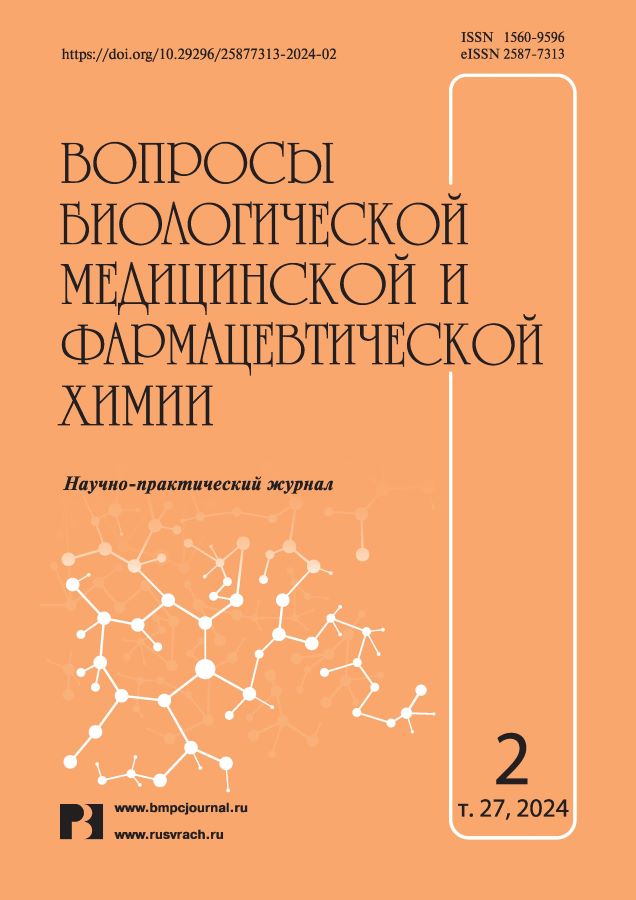Apoptotic and proinflammatory processes estimation in patients with diabetic neuropathy
- Authors: Obraztsova I.A.1, Popov S.S.1, Verevkin A.N.2, Pashkova A.A.1, Kryl'skii E.D.2, Popova T.N.2
-
Affiliations:
- Voronezh State Medical University named after N.N. Burdenko of the Ministry of Health of Russia
- Voronezh State University
- Issue: Vol 27, No 2 (2024)
- Pages: 3-9
- Section: Medical chemistry
- URL: https://journals.eco-vector.com/1560-9596/article/view/625796
- DOI: https://doi.org/10.29296/25877313-2024-02-01
- ID: 625796
Cite item
Abstract
Introduction. Diabetes mellitus and its complications remain one of the leading global diseases. Although there has been significant progress in diabetic peripheral neuropathy (DPN) diagnostics and treatment, the search for the molecular basis of its pathogenesis remains relevant. This search will enable targeted action on specific molecules and increase treatment effectiveness. Aim of the study. The aim of the present study was to analyse the mRNA levels of nuclear factor kappa-bi (NF-kB), apoptosis-inducing factor (AIF) and fibroblast growth factor 21 (FGF21), as well as changes in clinical and biochemical parameters in DPN patients undergoing inpatient treatment.
Material and methods. DPN patients (n=45) undergoing inpatient treatment were included in the study. Clinical and biochemical parameters were analysed on admission and before discharge. Transcript levels of the AIF and NF-kB genes were determined by real-time reverse transcription-polymerase chain reaction. FGF21 levels were determined by enzyme-linked immunosorbent assay.
Results. On admission to the hospital, the patients showed the main clinical signs of DPN. After treatment, there was a change in blood biochemical parameters towards control values (p<0.05). At the same time, there was a decrease in the mRNA level of the factors NF-kB (p=0.021) and AIF (p=0.015) in the patients' blood cells. There was an increase in FGF21 levels. Correlations were found between clinical and biochemical parameters, transcript levels of NF-kB and AIF factors and FGF21 levels.
Conclusion. The conducted studies testify about the positive influence of the therapy carried out in the hospital conditions on inflammatory and apoptotic processes, which is evidenced by the decrease in the mRNA level of the NF-κB and AIF factors genes, as well as by the increase in the concentration of FGF21, which is apparently associated with the decrease in the oxidative stress intensity.
Full Text
About the authors
I. A. Obraztsova
Voronezh State Medical University named after N.N. Burdenko of the Ministry of Health of Russia
Email: wer.all@mail.ru
Post-graduate Student, Department of Polyclinic Therapy
Russian Federation, VoronezhS. S. Popov
Voronezh State Medical University named after N.N. Burdenko of the Ministry of Health of Russia
Email: wer.all@mail.ru
Dr.Sc. (Med.), Associate Professor, Head of the Department of Organisation of Pharmaceutical Business, Clinical Pharmacy and Pharmacognosy
Russian Federation, VoronezhA. N. Verevkin
Voronezh State University
Author for correspondence.
Email: wer.all@mail.ru
Ph.D. (Biol.), Associate Professor, Department of Medical Biochemistry, Molecular and Cell Biology
Russian Federation, VoronezhA. A. Pashkova
Voronezh State Medical University named after N.N. Burdenko of the Ministry of Health of Russia
Email: wer.all@mail.ru
Dr.Sc. (Med.), Professor, Head of the Department of Polyclinic Therapy
Russian Federation, VoronezhE. D. Kryl'skii
Voronezh State University
Email: wer.all@mail.ru
Ph.D. (Biol.), Associate Professor, Department of Medical Biochemistry, Molecular and Cell Biology
Russian Federation, VoronezhT. N. Popova
Voronezh State University
Email: wer.all@mail.ru
Dr.Sc. (Biol.), Professor, Head of the Department of Medical Biochemistry, Molecular and Cell Biology
Russian Federation, VoronezhReferences
- Davari M., Hashemi R., Mirmiran P. et al. Effects of cinnamon supplementation on expression of systemic inflammation factors, NF-kB and Sirtuin-1 (SIRT1) in type 2 diabetes: a randomized, double blind, and controlled clinical trial. Nutrition journal. 2020; 19(1): 1‒8.
- Galeshkalami N.S., Abdollahi M., Najafi R. et al. Alpha-lipoic acid and coenzyme Q10 combination ameliorates experimental diabetic neuropathy by modulating oxidative stress and apoptosis. Life sciences. 2019; 216: 101‒110.
- Novo N., Ferreira P., Medina M. The apoptosis-inducing factor family: Moonlighting proteins in the crosstalk between mitochondria and nuclei. IUBMB Life. 2021; 73(3): 568‒581.
- Molnár Á., Szentpéteri A., Lőrincz, H. et al. Change of Fibroblast Growth Factor 21 Level Correlates with the Severity of Diabetic Sensory Polyneuropathy after Six-Week Physical Activity. Rev. Cardiovasc. Med. 2022; 23(5): 160 (1‒10).
- Deng L., Du C., Song P. et al. The role of oxidative stress and antioxidants in diabetic wound healing. Oxidative Med. Cell. Longev. 2021; 2021: 1‒11.
- Tobon-Velasco J.C., Cuevas E., Torres-Ramos M.A. Receptor for AGEs (RAGE) as mediator of NF-kB pathway activation in neuroinflammation and oxidative stress. CNS Neurol. Disord. Drug Targets. 2014; 13(9): 1615‒1626.
- Spitaler M.M., Graier W.F. Vascular targets of redox signalling in diabetes mellitus. Diabetologia. 2002; 45: 476‒494.
- Scholz J., Woolf C.J. The neuropathic pain triad: neurons, immune cells and glia. Nature neuroscience. 2007; 10(11): 1361‒1368.
- Cameron N.E., Cotter M.A. Pro-inflammatory mechanisms in diabetic neuropathy: focus on the nuclear factor kappa B pathway. Current drug targets. 2008; 9(1): 60‒67.
- Karin M., Yamamoto Y., Wang Q.M. The IKK NF-κB system: a treasure trove for drug development. Nat. Rev. Drug Discov. 2004; 3(1): 17‒26.
- Susin S.A., Zamzami N., Castedo M. et al. Bcl-2 inhibits the mitochondrial release of an apoptogenic protease. J. Exp. Med. 1996; 184(4): 1331‒1341.
- Gómez-Sámano M.Á. Grajales-Gómez M., Zuarth-Vázquez J. M. et al. Fibroblast growth factor 21 and its novel association with oxidative stress. Redox biology. 2017; 11: 335‒341.
- Vallianou N., Evangelopoulos A., Koutalas P. Alpha-lipoic acid and diabetic neuropathy. Rev. Diabet. Stud. 2009; 6(4): 230‒236.
- Nagamatsu M., Nickander K.K., Schmelzer J.D. et al. Lipoic acid improves nerve blood flow, reduces oxidative stress, and improves distal nerve conduction in experimental diabetic neuropathy. Diabetes care. 1995; 18(8): 1160‒1167.
- Bolevich S., Milosavljevic I., Draginic N. et al. The effect of the chronic administration of DPP4-inhibitors on systemic oxidative stress in rats with diabetes type 2. Ser J ExpClin Res. 2019; 20(3): 199‒206.
- Pujadas G., De Nigris V., Prattichizzo F. et al. The dipeptidyl peptidase-4 (DPP-4) inhibitor teneligliptin functions as antioxidant on human endothelial cells exposed to chronic hyperglycemia and metabolic high-glucose memory. Endocrine. 2017 Jun; 56(3): 509‒520.
Supplementary files







